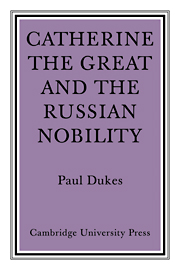 Catherine the Great and the Russian Nobilty
Catherine the Great and the Russian Nobilty 2 - Peter III, Catherine II and the nobility
Published online by Cambridge University Press: 31 March 2010
Summary
PETER III'S EMANCIPATION MANIFESTO
The year 1762 was important in the history of the nobility for two principal reasons: first, it saw the brief reign of Peter III, during which the class was emancipated from the burdens of obligatory service placed upon it by Peter the Great; secondly, Catherine II, whose relations with the dvorianstvo were to be of great importance, became Empress of Russia in June of that year.
Peter III, Catherine's husband, was usually represented by the Empress and her entourage as an imbecile totally incapable of the greatness which fate had attempted to thrust upon him, as ‘a permanent patch upon a very beautiful face’. Later critics have been kinder, and probably more accurate. As one of them has written, ‘Peter was notoriously unfit for ruling an Empire, but he would have made a good average eighteenth-century junker or squire’;. Not much more can be said for most of the other Romanovs.
Peter's ideal was Frederick the Great, and ‘by this fact alone can be explained the origin of several of the reforms of the strange sovereign who tried to imitate Frederick in everything’, according to S. S. Shashkov. A Prussian influence is certainly detectable in some of Peter's internal reforms, but he was also subject to domestic pressures applied by his advisers.
- Type
- Chapter
- Information
- Catherine the Great and the Russian NobiltyA Study Based on the Materials of the Legislative Commission of 1767, pp. 38 - 85Publisher: Cambridge University PressPrint publication year: 1967


